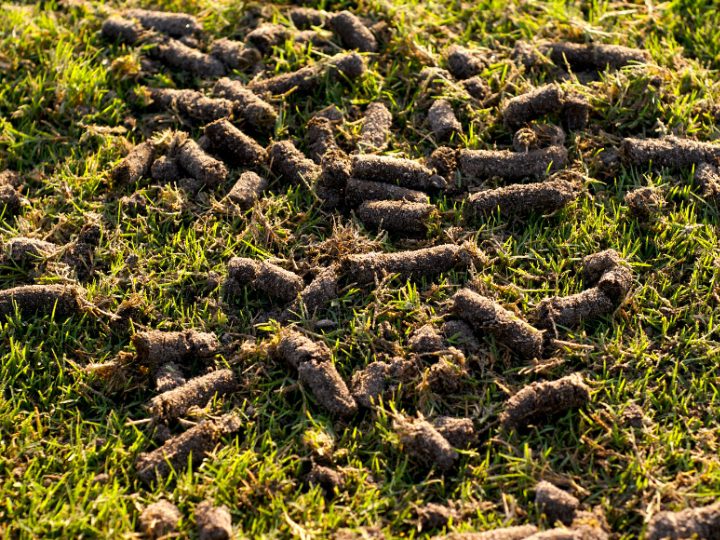Golfers always wonder why greens are being aerated. Often, they’ll comment “The greens were just getting good, and then you aerate?!”. Now while aeration may not look pretty, it is an important step in keeping the course green and the playing conditions superb. This article will explain the science and impact of golf course aeration.

Why Aerate?
Putting greens get a lot of foot traffic, in fact, more so than a tee box. With all this traffic the greens suffer from “compaction” which can weaken roots. Aeration clears out space on the greens to promote healthy roots and reduce thatch. Aeration will enable root systems to grow deeper into the soil. Thatch is basically old plant material that accumulates on the surface of the soil. It acts like a sponge, holding water near the surface which creates inconsistent green speeds and increases the likelihood of disease.
As mentioned previously, it often seems like aeration is done while the turf on the greens is performing at its best. This is because aeration is most effective when the grass is healthy and actively growing. Greens recover more quickly and weeds don’t have the opportunity to invade because the turf quickly recovers. This minimizes the amount of time the green will be sub-optimal for play. However – even at its worst the aeration only impacts 5-10% of the putting surface.
How to Aerate?
The step-by-step process on how to aerate a golf course is given below.
Topdressing, the process of filling the aeration holes with sand or other organic materials.
- Verticut the area of the golf course to be aerated. Verticutting is the process of removing excessive thatch that affects the firmness of the golf course and makes it spongy. Removing thatch opens up the turf to incorporate sand during aeration.
- Remove the clips left in the area after verticutting. These clips can be collected manually by backpacking them off.
- Aerate the area with a core aerator having 1/2 -inch coring tines. A core aerator has hollow tines that penetrate compacted soil on the golf greens to remove small plugs of soil and grass to reduce compaction.
- Pick up the cores of plugs left on the golf course after core aeration with a debris sweeper like Pro Sweep®, or if the area is small, you can do so by hand or use a shovel.
- Topdress the aerated area with good quality sand to fill the holes created during aeration. Topdressing increases the firmness of golf greens and improves drainage.
- Wait till the sand is completely dry with zero moisture, and then drag it properly into the holes with a brush. TB 200 is a good brush for this as it has two round brushes that rotate in opposite directions to ensure that sand from both directions is dragged into the holes properly.
- If any sand is still left on the golf course after the previous step, you can blow it off using a turbine blower.
- Add fertilizer to the aerated and topdressed area to restore any lost nutrients to the golf course and help the turf recover faster.
- Water the fertilizer and the sand into the area for best results.
Best Practices:
Greens two months after aeration.
- Filling aeration holes with sand improves drainage, speeds up recovery, and contributes to a firm and smooth putting surface. It also provides a putting surface that is immediately playable, with the sand smoothing out the surface.
- Complete the aeration when the turf on the green is growing, but avoid times when there is excess heat, rain, or shade. Generally, this will be in the late Spring. The aerated hole creates the potential for heaving where the roots are separated from the soil. This will both slow down the recovery time and make the putting surface softer than it was before the aeration. Late Summer can be a popular time, but with the heat from the sun, the sand used to fill the aerated holes can get very hot and cause stress to the turf. Additionally, the weakened turf in the late summer will likely not recover during the Fall and the greens may remain weak until the following Spring.
- Certain courses may not be able to complete the aeration in the late Spring due to play volume. In those cases, aeration in the early Fall followed by less aggressive aeration in the early Spring will achieve solid results. However, it is twice as much work.
- The sand used to fill the aerated holes must be carefully applied to avoid abrading the turf to the potentially abrasive nature of the sand. Generally, the sand should be applied in stages to avoid causing damage.
- Careful nutrient balancing after aeration is critical, as apply excessive nitrogen on the turf will cause grass growth that will reduce green speed.
Golf Course Aeration and Golf Course Maintenance
Golf course aeration takes a lot of work and experience, and not everyone has access to that. With DTE Golfs trained and certified professionals, golf course maintenance programs can be developed for any course type, and any season. Consult a DTE Golf® professional today.
